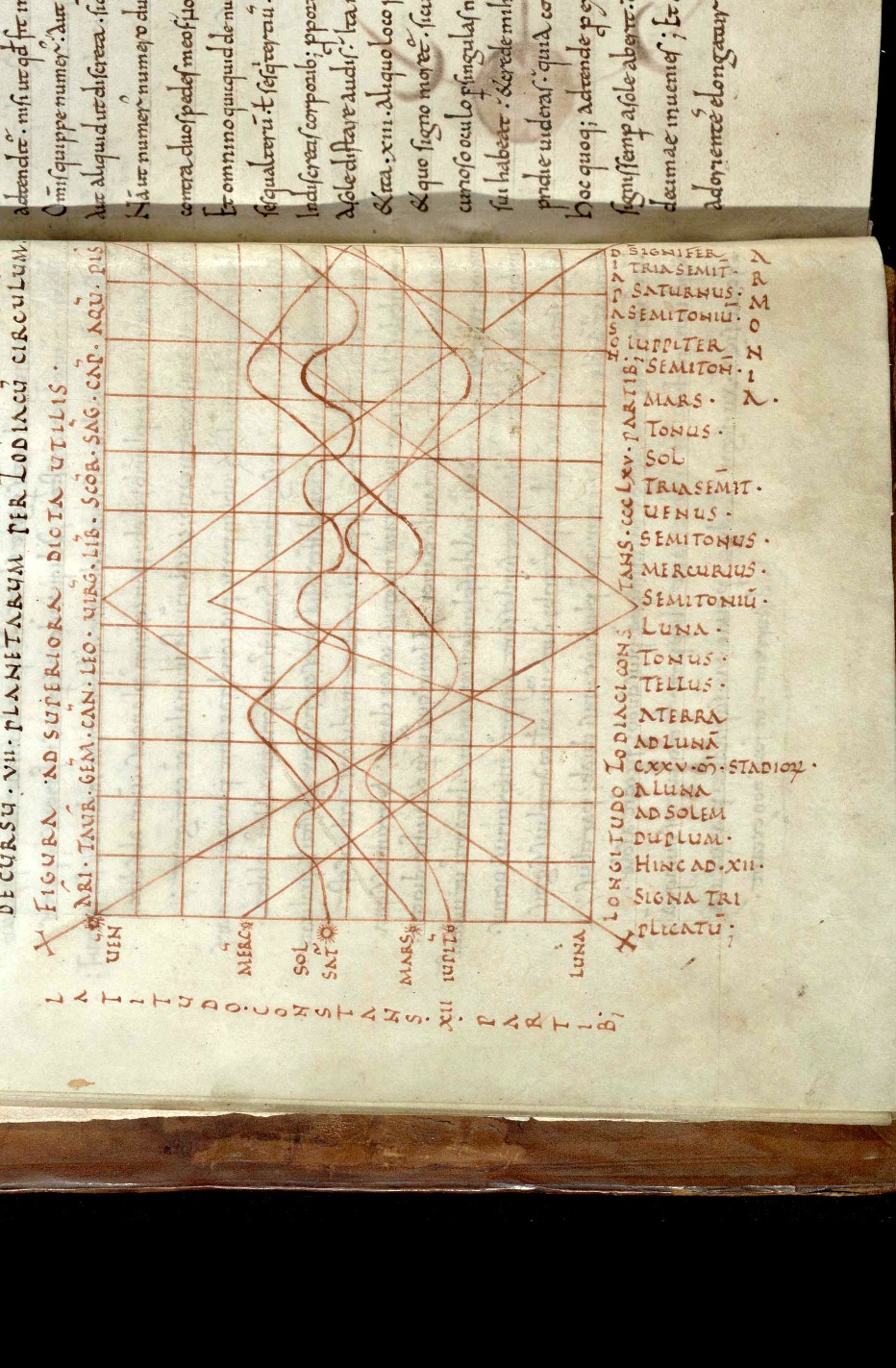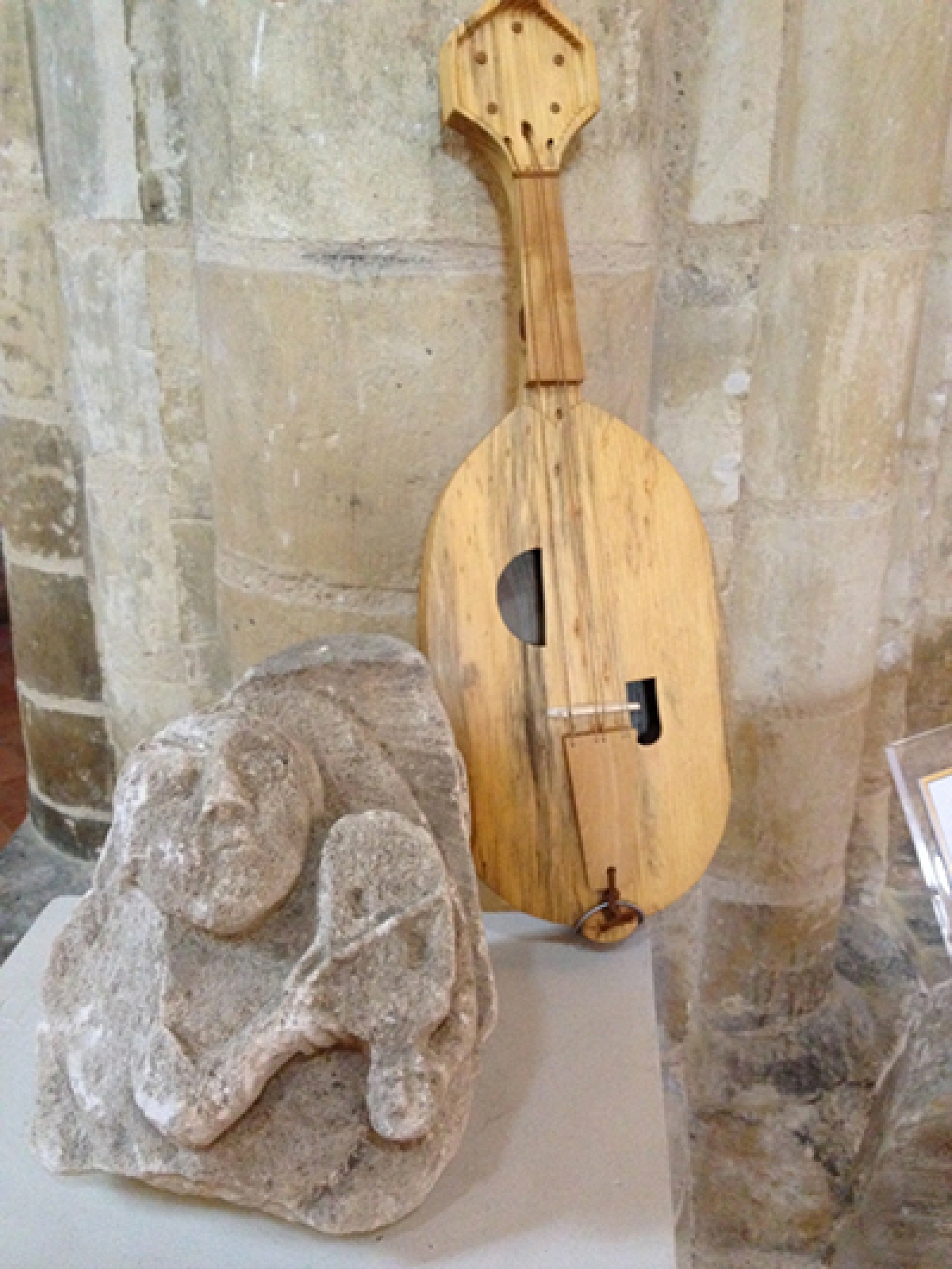Symphonia / Organistrum
keyboard
in Santiago de Compostela cathedral.
(Inquiry into a troubling problem of interpretation.
Analysis of possible solutions.)
FOREWORD
In former articles, I both wrote about different aspects of this problem and discussed practical means to build an acceptable replica of the instrument. My aim is to deal not only with organological and technical subjects but to examine musical ideas connected to them, the way Music was considered both as an art and as part of the mathematical knowledge of Nature, since Pythagoras to the Middle Ages and further.
FEW WITNESSES
Several researchers have already carefully studied the few witnesses related to this instrument. I am not going to repeat the whole list, I just want to offer a short survey here.
We can find many features common to all specimens: the soundbox, consisting, as usual, of two oval/circular parts plus the neck, three strings are stretched along this body, then a keyboard showing 6 to 8 keys within the half of the diapason, sound holes are often in a D shape. The keyboard mechanism is depicted only once, in an 18th-century copy (Gerbert) of a 13th c. deperditum manuscript: 8 revolving keys and the list of the notes, from C to c (including Bb and B) are clearly visible. This drawing tells us clearly that one of the strings, (maybe all the three strings) was in C and that the three strings were touched by each key at the same time following a diatonic scale.
The six letters on the right compose the word magada (latin but having greek origins) written at the right place, around the wheel and the bridge. (In musical treatises, i.e. the manuscript containing the most famous Ad organum faciendum in Biblioteca Ambrosiana, Milan, XI c., magada is the name given to the bridges of the monochord)

Another well known 13th-century manuscript entitled “Quomodo organistrum construatur” illustrates the method to divide the monochord into the eight stops of a diatonic scale starting from Ut, but we don't find a description of the instrument nor information about its use. Scholars guess it was played mainly for sacred music along the 12th century. Christopher Page, the only one who faced the problem of the name: Symhonia / Organistrum, has several doubts about and no definite answers.
SOME FEW SPECIMENS
We know that almost all depictions and witnesses belong to the 12th century, but the year and the decade are mainly unknown. Since it is impossible to follow an exact chronology we cannot pretend to outline the evolution of this instrument. To study carefully the observable features is the only serious way to face the subject.
In Ahedo de Butron (Burgos) sculpture, one of the musicians might be turning a crank with his right hand, while with his left-hand forefinger he is actually touching the second string of five; the second musician is touching the third string with his right-hand forefinger and with the other hand is turning the corresponding tuning peg.
 Hortus deliciarum
Hortus deliciarum
There is no evidence of a keyboard in Hortus deliciarum manuscript. In Ahedo, since there is no trace of both crank and wheel, possibly the two musicians are either just tuning a long size Viella or tuning an Organistrum with no keyboard:
 Ahedo de Butron
Ahedo de Butron
In Soria sculpture (Spain) we observe only one string (?), no bridge, no wheel, no keys. The musicians look as they were actually turning a wheel and pulling the keys, but the damages suffered by this sculpture do preclude a clear observation of details. On the contrary, the similarly shaped instrument in Boscherville capital (France) presents crank, tailpiece, wheel, and keys.
 Boscherville
Boscherville
What was this wheel intended to do, but to produce a continuous sound? This is the first observation with musical relevance in our description. Now, suppose we have built a long size Viella, about twice the size of a usual one, with a wheel in it: one of the two musicians can stop the strings all along the neck with his fingers, but he is not at ease cause his fingers interfere accidentally with the other strings. This is why a system of keys might have been suggested. In some depictions they appear, 6 to 8 within half of the diapason. They look like flat bars passing beneath the strings (Boscherville and Vercelli) or we can see the top of them protruding from the lid that hides the inner mechanism. That these keyboards were designed for a diatonic scale is out of doubt. The question is: were the bars equipped with tangents in order to operate on one string only or more than one?
According to Gerbert’s drawing, all keys are acting on the three strings simultaneously in order to play a simple melody on the three strings tuned at the same pitch. No other useful information is offered by the drawing : no indication of drones, no alternative tunings.
Eventually, if we want to extend the c scale, we should tune the lateral strings in c, the middle one in c'. Then, by lifting the middle string and then the two laterals, (this task carried out by the man in charge of turning the wheel) we can obtain two full octaves.
NO DRONES
As we assume that the instrument served to sacred music only, no use of drones have to be admitted, according to western tradition (although many scholars nowadays, influenced by byzantine fashion, perform gregorian chants also adding drones)
POSSIBLE REPERTOIR
During the XII century benedictine monks were developing a new technique in polyphonic singing:
the vox organalis was no longer in parallelum, dismitting the teaching of Musica enchiriadis and Micrologus, and became freer.
What was the new instrument role in that new music fashion?
To play the tenor part in organum melismaticum or floridum for instance, as a ground reference for the upper voice.
A similar role (and similar limits as well) would pertain to the romanesque pipe organ (see J.Ferrando's article in: L'instrumentarium du Moyen Age. Paris, L'Harmattan,2015).
The geographic area includes Spain and France mainly, then England, Germany, and Italy
SANTIAGO DE COMPOSTELA INSTRUMENT

At the top of the Gate of Glory in Santiago de Compostela cathedral magister Mateus sculpted a wheel instrument in the middle of the range of the 24 Elders of Apocalypse all around the Lamb. This gate is dated precisely the year 1188. This specimen differs from all others we have examined
- In its general shape
- In quantity and quality of decorations
- Having 11 keys within the octave.
The soundbox consists of two perfect circles connected through lobes and a rectangular box containing the keys. The string length is equal to the circumference of circles. Four triangular sound holes with little holes at the edges are cut in the first circle. A large quadripartite rosette with vegetable decoration is carved in the second circle. An interlace decoration made of 11 knots and 12 spaces is cut all along the rectangular keyboard lid.
Some of these features are unique among all depictions of the instrument. In other articles, I examined these characteristics in the light of musical theory, astronomy, and cosmology of the time. In the present paper I would like to focus on the interpretation of the keyboard with 11 keys within the octave, describing a possible reconstruction of it.
Many important scholars believe that this number indicates a chromatic division of the keyboard. Although they are aware of the fact that no chromatic scale was in use in the 12th-century music, they accept as a piece of absolute evidence that this abnormal chromatic keyboard was used for transposition. This is absurd because no full transposition of any melodic line spanning one octave at least can be made within a single octave!
My idea is that this setting of keys could be only apparently chromatic and might serve a diatonic scale, this way: two lateral bass strings (a), middle treble string (a') whose nut lies a semitone behind the other two. This pattern works only with this tuning, enlarging Gerbert diatonic scale two tones under the c and reaching the g' of the second octave, including all useful notes of tenor parts in XII century organum melismaticum.
Please look at the next picture: notice the first octave blue (no b flat here), the second octave red (chance on 8th bar only between e first octave and f second octave obtained by turning 90° the cilindric bar)

Please, watch the video:
https://www.youtube.com/watch?v=B6vv4IPGgRk
CONCLUSIONS
This report gives rise to more doubts than certainties.
Santiago instrument appears to be the more complicated version of a wheel instrument documented for few decades during the 12th century, whose main relevance was due primarily to the continuous sound produced by the wheel, secondarily to the keyboard mechanism.
We know nothing about the wheel and we assume it was a wooden one with rosin on it. Then we don't know whether the performer used to lift any of the strings from the wheel occasionally or not.
We ignore both the tuning and the keyboard mechanism in detail. It is possible that different solutions have been adopted here and there in different moments and places, including a simpler version with no keyboard at all.
At the beginning of the XIII century the instrument disappeared. Wheel instruments survived into smaller forms, playable by one performer, being equipped with a more practical keyboard, to serve secular music.
THE BOOK
A new video:
https://www.youtube.com/watch?v=csI1VMcDW_E&t=2s
Read more:
https://ojs.unito.it/index.php/archeologiesperimentali/article/view/8489










